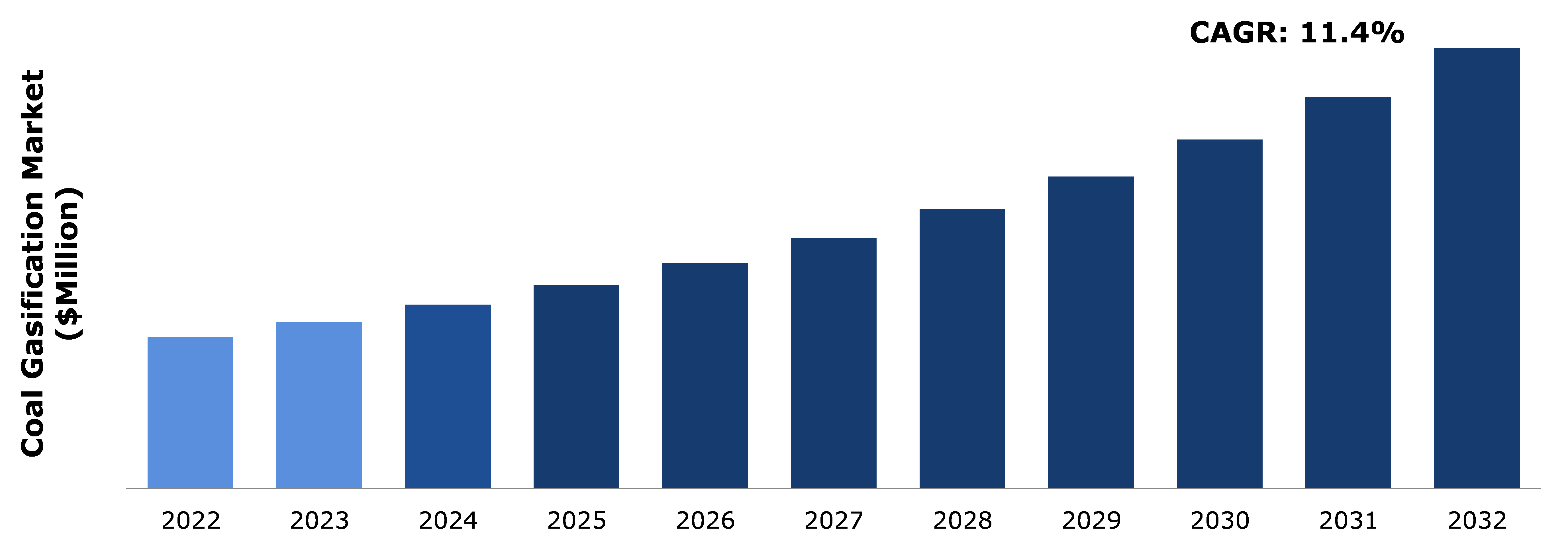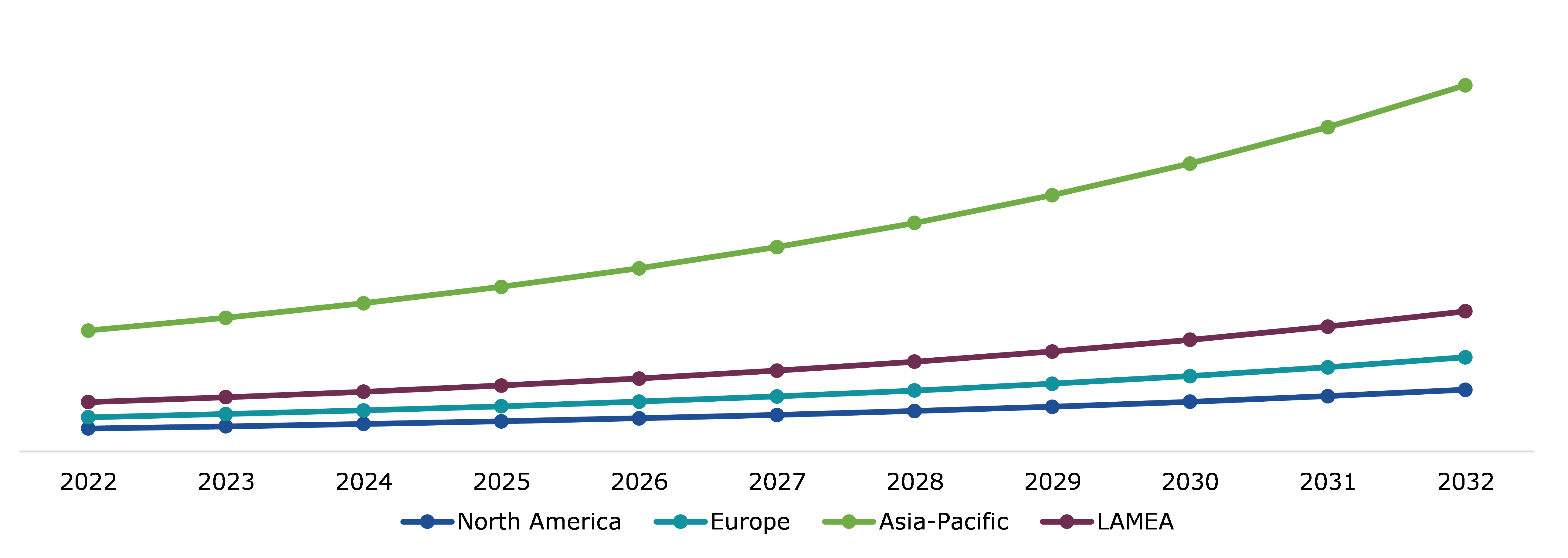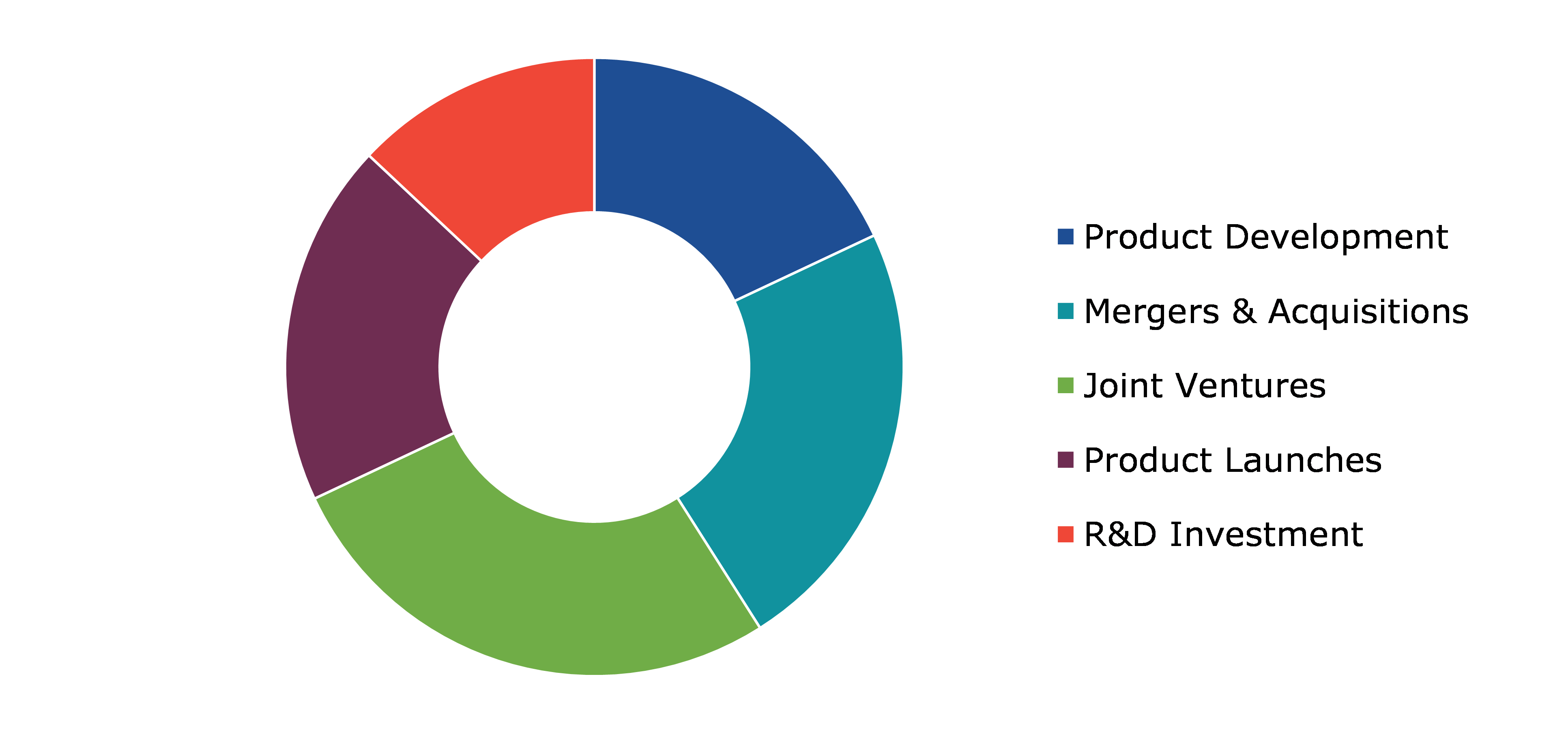Coal Gasification Market Report
RA09170
Coal Gasification Market by Gasifier (Fixed Bed, Fluidized Bed, and Entrained Flow), Application (Fertilizers, Electricity Generation, Chemicals, Hydrogen Generation, Steel Production, and Others), and Region (North America, Europe, Asia-Pacific, and LAMEA): Opportunity Analysis and Industry Forecast, 2023-2032
Coal Gasification Overview
Coal gasification stands as a prominent advancement in eco-friendly coal technology. Coal gasification converts coal into gas, mainly serving as a fuel source or a raw material for chemicals sector where coal gasification is used for syngas production, ammonia production, methanol production, and others. In simpler terms, this process morphs coal into a more convenient gaseous state for immediate use. Though the concept of coal-to-gas conversion isn't novel and has undergone testing over the past two centuries, it has been abandoned several times. Post-World War II, the global shift towards more affordable natural gas and oil led to diminished coal gas usage worldwide, except in South Africa and a few emerging nations. Conversely, the 1973 oil crisis prompted a profound reassessment of oil-coal dynamics in terms of pricing and availability. This, in turn, generated substantial interest in coal gasification technology, resulting in various coal gasification systems. Some of these techniques, categorized as second-generation coal gasification technologies, have demonstrated remarkable efficiency.
Global Coal Gasification Market Analysis
The global coal gasification market size was $186,939.9 million in 2022 and is predicted to grow with a CAGR of 11.4%, by generating a revenue of $544,218.1 million by 2032.
Source: Research Dive Analysis
COVID-19 Impact on Global Coal Gasification Market
In May 2020, during the pandemic's first wave, global economies grappled with lockdowns, movement restrictions, and disrupted trade, leading to supply chain complications. These disruptions affected the availability of necessary equipment, materials, and components crucial for coal gasification ventures. These interruptions have contributed to sluggish global activity and trade, primarily attributed to challenges in logistics and transportation, economic constraints from pandemic measures, and labor shortages across industries. Evidently, since late 2020, extended delivery times from suppliers across advanced economies have underscored the strain on global production networks.
Energy Security Provided by Coal Gasification to Drive the Market Growth
Coal gasification industry has a wide range of applications in electricity across electricity generation, in the petrochemicals industry for the production of olefins such as propylene and ethylene. In addition, the coal-derived syngas can facilitate the creation of diverse chemicals like methanol, ammonium nitrate, urea, hydrogen, etc., which are currently reliant on imported LNG. As gas prices rise and supply becomes erratic, this approach becomes economically and strategically compelling. It's noteworthy that China, with extensive coal stores, has collaborated with Western technology in coal gasification since the 1950s, and currently, it derives 90% of its ammonia, 70% of its methanol, 2.5 MTPA ethylene glycol, etc., from this method. The coal gasification process yields nearly pure CO2 as a byproduct, simplifying and economizing carbon capture, making it conducive to integrated gasification. Due to the cost-efficient nature of carbon capture in this procedure, the feasibility of clean electricity from coal via the IGCC approach is poised to surpass that of coal-based power plants with carbon capture from flue gases. Unquestionably, coal gasification is set to be a pivotal technology in the coming years, powering both clean energy generation and the production of valuable chemicals using domestic resources. This considerable surge in clean energy from coal gasification spurs demand for process adoption, fueling market expansion.
Economic Viability of Coal Gasification Process to Restrain the Market Growth
Establishing and operating coal gasification endeavors can demand substantial capital investments. The initial expenses associated with constructing gasification facilities, coupled with ongoing operational outlays, might render it comparatively less economically appealing when contrasted with alternative energy sources or cleaner technologies. The upfront expenditures tied to sizeable gasification projects continue to pose a challenge. Although alternatives with lower capital requirements exist, they are improbable replacements for extensive gasification undertakings, which offer cost-efficient end products and the capacity to meet substantial market demands, particularly in sectors like chemicals and fertilizers. The task of reducing initial costs or sourcing necessary investments remains an ongoing obstacle.
Hydrogen Production from Coal Gasification to Give Excellent Opportunities
Syngas derived from coal gasification has the potential to serve as a versatile and eco-friendly source of hydrogen, a versatile energy carrier crucial for various processes such as refining, ammonia production, and in fuel cells for power generation. As the demand for clean hydrogen rises, coal gasification could play a pivotal role in hydrogen supply. In the current U,S, scenario, hydrogen mainly stems from fossil fuels, with over 70% originating from natural gas and approximately 27% from coal. Only a fraction, less than 1%, is generated via electricity-driven electrolysis, which indirectly ties back to fossil fuels as the electricity for electrolysis primarily originates from fossil fuels in hydrogen-producing nations. Projections suggest that by 2050, hydrogen demand could reach 650 million metric tons per year, marking a fivefold increase from present production levels. Given the favorable economics of coal gasification and natural gas reforming, these methods are expected to remain the most cost-effective means of producing large-scale hydrogen in the short and medium term. The ability to generate pure hydrogen through coal gasification, along with its growing prominence as a cleaner fuel option, has the potential to significantly drive the coal gasification market growth during the forecast period.
Global Coal Gasification Market Share, by Gasifier, 2022
Source: Research Dive Analysis
The fluidized bed sub-segment accounted for the highest market share in 2022. Fluidized bed gasifiers offer high efficiency as well as allow for efficient gasification process by dealing with variety of feedstocks such as biomass, waste materials, coal, petroleum coke, and others. = This is because the fluidized bed gasifiers operate at relatively lower temperatures compared to entrained flow gasifiers. This moderate temperature range is crucial for efficient gasification as it reduced the production of tar and other undesirable byproducts. In addition, the fluidized bed gasifiers can deal with a wide range of coal types as well as qualities such as low-grade coal or even coal wastes. This includes lower-grade coals and even coal waste. Furthermore, the fluidized bed process involves suspending coal particles within a bed of inert material, for instance, sand. This bed of inert material leads to excellent mixing and contact between the coal particles and gasifying agents namely oxygen, air, or steam for an efficient gasification process. These factors are anticipated to boost the fluidized bed gasifiers market share in the coming years.
Global Coal Gasification Market Share, by Application, 2022
Source: Research Dive Analysis
The electricity generation sub-segment accounted for the highest market share in 2022. Coal gasification is widely used for electricity generation as it is more efficient compared to conventional coal-fired power plants. This is because the gasification process helps in cleaner and more concentrated syngas production that can be burned in a gas turbine. Efficient syngas production results in higher energy conversion efficiencies which results in high electricity production per unit of coal input. In addition, coal gasification power plants can be integrated with carbon capture and utilization (CCU) technologies. The CCU technologies are becoming popular across the world as these technologies can capture, store, and utilize carbon dioxide emissions for mitigating climate change by reducing greenhouse gas emissions. These factors are anticipated to drive the popularity of coal gasification for the electricity generation process in the coming years.
Global Coal Gasification Market Size & Forecast, by Region, 2022-2032 ($Million)
Source: Research Dive Analysis
The Asia-Pacific coal gasification market generated the highest revenue in 2022. The popularity of coal gasification in the Asia-Pacific countries is driven by the presence of abundant coal reserves, rapid industrialization, and growing demand for energy security. For instance, China and India have high coal reserves. Thus, coal gasification offers an efficient way to harness these domestic energy resources for several applications such as electricity generation, steel processing, hydrogen generation, and others. For instance, in India, the Ministry of Coal has set a target to gasify 100 million tons of coal by 2030. This initiative will boost the energy transition in the country. In addition, the widespread adoption of coal gasification technologies in the country is estimated to revolutionize the coal sector, thereby reducing the dependence on the import of natural gas, ammonia, methanol, and fossil fuels. In addition, the Ministry of Coal, India, is considering a Rs 6,000 crore ($60,000 million) coal gasification scheme to boost the coal gasification projects across public and private sectors as stated in July 2023. Also, in China, almost 70% of hydrogen is generated via coal gasification. Such initiatives are projected to drive the coal gasification market opportunities in the Asia-Pacific region during the forecast period.
Competitive Scenario in the Global Coal Gasification Market
Investment, business expansion, and partnership are common strategies followed by major market players. In May 2023, Coal India Limited, the coal mining company, announced to invest Rs 91,000 crores ($910,000 million) in diversification and mine development projects by 2026. This investment is estimated to boost the popularity of coal gasification projects in the coming years.
Source: Research Dive Analysis
Some of the leading coal gasification market players are Air Liquide, Mitsubishi Heavy Industries Ltd., Air Products, Thyssenkrupp Uhde GmbH, Andritz, Dakota Gasification Company, Sedin Engineering Co Ltd., Sasol Limited, Linc Energy Ltd., and Shanxi Lu'an Mining Group Co., Ltd.
| Aspect | Particulars |
| Historical Market Estimations | 2020-2021 |
| Base Year for Market Estimation | 2022 |
| Forecast Timeline for Market Projection | 2023-2032 |
| Geographical Scope | North America, Europe, Asia-Pacific, and LAMEA |
| Segmentation by Gasifier |
|
| Segmentation by Application |
|
| Key Companies Profiled |
|
Q1. What is the size of the global coal gasification market?
A. The size of the global coal gasification market was over $186,939.9 million in 2022 and is projected to reach $544,218.1 million by 2032.
Q2. Which are the major companies in the coal gasification market?
A. Thyssenkrupp Uhde GmbH, Andritz, and Dakota Gasification Company are some of the key players in the global coal gasification market.
Q3. Which region, among others, possesses greater investment opportunities in the future?
A. Asia-Pacific possesses great investment opportunities for investors in the future.
Q4. What will be the growth rate of the Asia-Pacific coal gasification market?
A. Asia-Pacific coal gasification market is anticipated to grow at a CAGR of 11.8% during the forecast period.
Q5. What are the strategies opted by the leading players in this market?
A. Investment, agreement, and business expansion are the two key strategies opted by the operating companies in this market.
Q6. Which companies are investing more on R&D practices?
A. Air Liquide, Mitsubishi Heavy Industries Ltd., Air Products¸ and SEDIN Engineering Co., Ltd. are the companies investing more on R&D activities for developing new products and technologies.
1. Research Methodology
1.1. Desk Research
1.2. Real time insights and validation
1.3. Forecast model
1.4. Assumptions and forecast parameters
1.5. Market size estimation
1.5.1. Top-down approach
1.5.2. Bottom-up approach
2. Report Scope
2.1. Market definition
2.2. Key objectives of the study
2.3. Report overview
2.4. Market segmentation
2.5. Overview of the impact of COVID-19 on global coal gasification market
3. Executive Summary
4. Market Overview
4.1. Introduction
4.2. Growth impact forces
4.2.1. Drivers
4.2.2. Restraints
4.2.3. Opportunities
4.3. Market value chain analysis
4.3.1. List of raw material suppliers
4.3.2. List of manufacturers
4.3.3. List of distributors
4.4. Innovation & sustainability matrices
4.4.1. Technology matrix
4.4.2. Regulatory matrix
4.5. Porter’s five forces analysis
4.5.1. Bargaining power of suppliers
4.5.2. Bargaining power of consumers
4.5.3. Threat of substitutes
4.5.4. Threat of new entrants
4.5.5. Competitive rivalry intensity
4.6. PESTLE analysis
4.6.1. Political
4.6.2. Economical
4.6.3. Social
4.6.4. Technological
4.6.5. Environmental
4.7. Impact of COVID-19 on coal gasification market
4.7.1. Pre-covid market scenario
4.7.2. Post-covid market scenario
5. Coal Gasification Market Analysis, by Gasifier
5.1. Overview
5.2. Fixed Bed
5.2.1. Definition, key trends, growth factors, and opportunities
5.2.2. Market size analysis, by region, 2022-2032
5.2.3. Market share analysis, by country, 2022-2032
5.3. Fluidized Bed
5.3.1. Definition, key trends, growth factors, and opportunities
5.3.2. Market size analysis, by region, 2022-2032
5.3.3. Market share analysis, by country, 2022-2032
5.4. Entrained Flow
5.4.1. Definition, key trends, growth factors, and opportunities
5.4.2. Market size analysis, by region, 2022-2032
5.4.3. Market share analysis, by country, 2022-2032
5.5. Research Dive Exclusive Insights
5.5.1. Market attractiveness
5.5.2. Competition heatmap
6. Coal Gasification Market Analysis, by Application
6.1. Fertilizers
6.1.1. Definition, key trends, growth factors, and opportunities
6.1.2. Market size analysis, by region, 2022-2032
6.1.3. Market share analysis, by country, 2022-2032
6.2. Electricity Generation
6.2.1. Definition, key trends, growth factors, and opportunities
6.2.2. Market size analysis, by region, 2022-2032
6.2.3. Market share analysis, by country, 2022-2032
6.3. Chemicals
6.3.1. Definition, key trends, growth factors, and opportunities
6.3.2. Market size analysis, by region, 2022-2032
6.3.3. Market share analysis, by country, 2022-2032
6.4. Hydrogen Generation
6.4.1. Definition, key trends, growth factors, and opportunities
6.4.2. Market size analysis, by region, 2022-2032
6.4.3. Market share analysis, by country, 2022-2032
6.5. Steel Production
6.5.1. Definition, key trends, growth factors, and opportunities
6.5.2. Market size analysis, by region, 2022-2032
6.5.3. Market share analysis, by country, 2022-2032
6.6. Others
6.6.1. Definition, key trends, growth factors, and opportunities
6.6.2. Market size analysis, by region, 2022-2032
6.6.3. Market share analysis, by country, 2022-2032
6.7. Research Dive Exclusive Insights
6.7.1. Market attractiveness
6.7.2. Competition heatmap
7. Coal Gasification Market, by Region
7.1. North America
7.1.1. U.S.
7.1.1.1. Market size analysis, by Gasifier, 2022-2032
7.1.1.2. Market size analysis, by Application, 2022-2032
7.1.2. Canada
7.1.2.1. Market size analysis, by Gasifier, 2022-2032
7.1.2.2. Market size analysis, by Application, 2022-2032
7.1.3. Mexico
7.1.3.1. Market size analysis, by Gasifier, 2022-2032
7.1.3.2. Market size analysis, by Application, 2022-2032
7.1.4. Research Dive Exclusive Insights
7.1.4.1. Market attractiveness
7.1.4.2. Competition heatmap
7.2. Europe
7.2.1. Germany
7.2.1.1. Market size analysis, by Gasifier, 2022-2032
7.2.1.2. Market size analysis, by Application, 2022-2032
7.2.2. Russia
7.2.2.1. Market size analysis, by Gasifier, 2022-2032
7.2.2.2. Market size analysis, by Application, 2022-2032
7.2.3. UK
7.2.3.1. Market size analysis, by Gasifier, 2022-2032
7.2.3.2. Market size analysis, by Application, 2022-2032
7.2.4. Belgium
7.2.4.1. Market size analysis, by Gasifier, 2022-2032
7.2.4.2. Market size analysis, by Application, 2022-2032
7.2.5. Spain
7.2.5.1. Market size analysis, by Gasifier, 2022-2032
7.2.5.2. Market size analysis, by Application, 2022-2032
7.2.6. Rest of Europe
7.2.6.1. Market size analysis, by Gasifier, 2022-2032
7.2.6.2. Market size analysis, by Application, 2022-2032
7.2.7. Research Dive Exclusive Insights
7.2.7.1. Market attractiveness
7.2.7.2. Competition heatmap
7.3. Asia-Pacific
7.3.1. China
7.3.1.1. Market size analysis, by Gasifier, 2022-2032
7.3.1.2. Market size analysis, by Application, 2022-2032
7.3.2. Japan
7.3.2.1. Market size analysis, by Gasifier, 2022-2032
7.3.2.2. Market size analysis, by Application, 2022-2032
7.3.3. India
7.3.3.1. Market size analysis, by Gasifier, 2022-2032
7.3.3.2. Market size analysis, by Application, 2022-2032
7.3.4. Indonesia
7.3.4.1. Market size analysis, by Gasifier, 2022-2032
7.3.4.2. Market size analysis, by Application, 2022-2032
7.3.5. Australia
7.3.5.1. Market size analysis, by Gasifier, 2022-2032
7.3.5.2. Market size analysis, by Application, 2022-2032
7.3.6. Rest of Asia-Pacific
7.3.6.1. Market size analysis, by Gasifier, 2022-2032
7.3.6.2. Market size analysis, by Application, 2022-2032
7.3.7. Research Dive Exclusive Insights
7.3.7.1. Market attractiveness
7.3.7.2. Competition heatmap
7.4. LAMEA
7.4.1. Brazil
7.4.1.1. Market size analysis, by Gasifier, 2022-2032
7.4.1.2. Market size analysis, by Application, 2022-2032
7.4.2. Saudi Arabia
7.4.2.1. Market size analysis, by Gasifier, 2022-2032
7.4.2.2. Market size analysis, by Application, 2022-2032
7.4.3. Chile
7.4.3.1. Market size analysis, by Gasifier, 2022-2032
7.4.3.2. Market size analysis, by Application, 2022-2032
7.4.4. South Africa
7.4.4.1. Market size analysis, by Gasifier, 2022-2032
7.4.4.2. Market size analysis, by Application, 2022-2032
7.4.5. Rest of LAMEA
7.4.5.1. Market size analysis, by Gasifier, 2022-2032
7.4.5.2. Market size analysis, by Application, 2022-2032
7.4.6. Research Dive Exclusive Insights
7.4.6.1. Market attractiveness
7.4.6.2. Competition heatmap
8. Competitive Landscape
8.1. Top winning strategies, 2022
8.1.1. By strategy
8.1.2. By year
8.2. Strategic overview
8.3. Market share analysis, 2022
9. Company Profiles
9.1. Air Liquide
9.1.1. Overview
9.1.2. Business segments
9.1.3. Product portfolio
9.1.4. Financial performance
9.1.5. Recent developments
9.1.6. SWOT analysis
9.2. Mitsubishi Heavy Industries Ltd.
9.2.1. Overview
9.2.2. Business segments
9.2.3. Product portfolio
9.2.4. Financial performance
9.2.5. Recent developments
9.2.6. SWOT analysis
9.3. Air Products
9.3.1. Overview
9.3.2. Business segments
9.3.3. Product portfolio
9.3.4. Financial performance
9.3.5. Recent developments
9.3.6. SWOT analysis
9.4. Thyssenkrupp Uhde GmbH
9.4.1. Overview
9.4.2. Business segments
9.4.3. Product portfolio
9.4.4. Financial performance
9.4.5. Recent developments
9.4.6. SWOT analysis
9.5. Andritz
9.5.1. Overview
9.5.2. Business segments
9.5.3. Product portfolio
9.5.4. Financial performance
9.5.5. Recent developments
9.5.6. SWOT analysis
9.6. Dakota Gasification Company
9.6.1. Overview
9.6.2. Business segments
9.6.3. Product portfolio
9.6.4. Financial performance
9.6.5. Recent developments
9.6.6. SWOT analysis
9.7. Sedin Engineering Co Ltd.
9.7.1. Overview
9.7.2. Business segments
9.7.3. Product portfolio
9.7.4. Financial performance
9.7.5. Recent developments
9.7.6. SWOT analysis
9.8. Sasol Limited
9.8.1. Overview
9.8.2. Business segments
9.8.3. Product portfolio
9.8.4. Financial performance
9.8.5. Recent developments
9.8.6. SWOT analysis
9.9. Linc Energy Ltd.
9.9.1. Overview
9.9.2. Business segments
9.9.3. Product portfolio
9.9.4. Financial performance
9.9.5. Recent developments
9.9.6. SWOT analysis
9.10. Shanxi Lu'an Mining Group Co., Ltd.
9.10.1. Overview
9.10.2. Business segments
9.10.3. Product portfolio
9.10.4. Financial performance
9.10.5. Recent developments
9.10.6. SWOT analysis
Personalize this research
- Triangulate with your own data
- Request your format and definition
- Get a deeper dive on a specific application, geography, customer or competitor
- + 1-888-961-4454 Toll - Free
- support@researchdive.com






